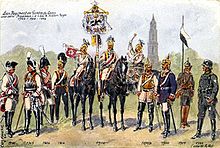Gardes du Corps (Prussia)
| Gardes du Corps | |
|---|---|
| Regiment der Gardes du Corps | |

Uniforms from 1740 to 1926
|
|
| Active | 1740 |
| Countries |
|
| Allegiance | House of Hohenzollern |
| Branch |
Prussian Army (1740-1871) German Army (1871-1919) |
| Type | Cuirassier |
| Role | Royal Guards |
| Part of | 1st Guards Cavalry Division |
| Motto(s) | Adelheit es ist soweit (Adelheit's time has come) |
| Decorations | Order of the Black Eagle |
| Disbanded | 1919 |
The Gardes du Corps (Regiment der Gardes du Corps) was the personal bodyguard of the king of Prussia and, after 1871, of the German emperor (in German, the Kaiser). The unit was founded in 1740 by Frederick the Great. Its first commander was Friedrich von Blumenthal, who died unexpectedly in 1745; his brother Hans von Blumenthal, who, with the other officers of the regiment had won the Pour le Mérite in its first action at the battle of Hohenfriedberg, assumed command in 1747. Hans von Blumenthal was badly wounded leading the regiment in a successful cavalry charge in the battle of Lobositz and had to retire from the military.
Initially, the Regiment was used in part as a training unit for officers as part of a programme of expansion of the cavalry. Early officers included the rake and memoirist Friedrich von der Trenck, who described the arduous life of sleep deprivation and physical stress endured by officers, as well as the huge cost of belonging to the unit (the cuirasses, for example, were silverplated at a time when the precious metal was exceptionally expensive).
Unlike the rest of the Imperial German Army after German unification in 1871, the Garde du Corps was recruited nationally and was part of the 1st Guards Cavalry Division. The Regiment wore a white cuirassier uniform with certain special distinctions in full dress. These included a red tunic for officers in court dress and a white metal eagle poised as if about to rise from the bronze helmet on which it sat. Other unique features of the regiment's full dress worn until 1914 included a red sleeveless Supraweste (survest) with the star of the Order of the Black Eagle on front and back and the retention of black iron cuirasses edged with red which had been presented by the Russian Tsar in 1814. These last replaced the normal white metal breastplates on certain special occasions.
...
Wikipedia
